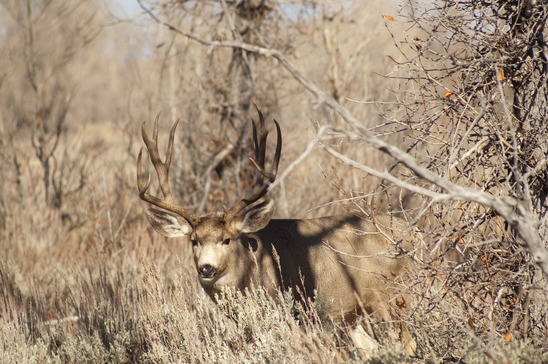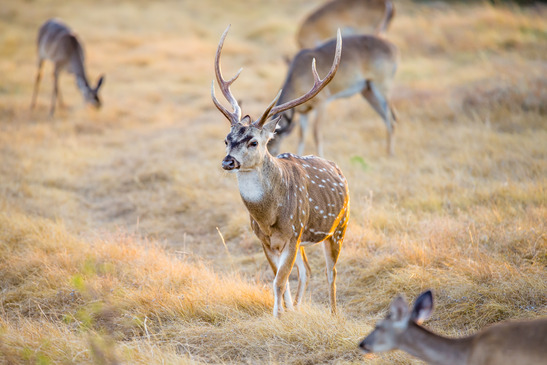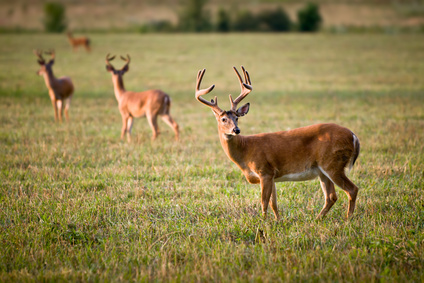A Way of Life in the USA
Hunting is a way of life in the United States, and we are here to help you be as successful on the hunt as possible.
The Top States for Deer Hunting
For an avid deer hunter, traveling comes with the sport. The National Deer Alliance conducted a survey in 2015, and according to the survey, 42 percent of deer hunters leave their state to go deer hunting. This has been happening regularly since 2012 too. The following will be a set of lists for a few types of deer, and the best states for to hunt them in. The lists will be length appropriate based on how widespread the type of deer is, and each state listed for each kind of deer will list some of the qualities for why it made the list.
The Mule Deer
 The mule deer makes its home west of the Missouri River, specifically west of the Rocky Mountains. There has been speculation in recent years concerning the availability of good, trophy-quality mule deer available. Wolf territory expansion and harsh winters have caused some problems for the mule deer, but several states are confronting the troublesome trend for hunters with some solid management practices to keep the numbers up. Conservation and wildlife agencies have changed some practices to help confront the declining population, so here is a list of good states to hunt mule deer in.
The mule deer makes its home west of the Missouri River, specifically west of the Rocky Mountains. There has been speculation in recent years concerning the availability of good, trophy-quality mule deer available. Wolf territory expansion and harsh winters have caused some problems for the mule deer, but several states are confronting the troublesome trend for hunters with some solid management practices to keep the numbers up. Conservation and wildlife agencies have changed some practices to help confront the declining population, so here is a list of good states to hunt mule deer in.
Arizona
This is a tricky state to describe, and a lot of hunters would debate this as a pick. There is a strip of Arizona in Unit 13. Several sub-zones in in Unit 13 are well known to have quality mule deer, but they are not sought out as much lately due to a low tag percentage. The reason it made this list goes back to growing numbers. This is a great area to hunt mule deer again because management has stepped up, there is better access to hunting areas, habitat work and quotas have all come together to turn out big bucks, and there are a lot more of them now too.
Desert shrub, grasslands, pinon-juniper, pine, aspen-fir, and mountain meadows, but the deer are known to prefer rugged country. There is a also a mix of private and public hunting with many places offering the services of guides.
Colorado
Colorado might be the most ideal state to score a trophy mule deer. It has the best and most efficient management of the population. Certain sections in Colorado seem to yield better point bucks. Eagle, Garfield and Mesa counties are the best places to go. If you prefer to hunt in plains terrain, then focus on the Colorado Eastern Plains, and bow-hunters are especially fond of hunting mule deer in the plains.
The terrain in Eagle, Garfield and Mesa counties are rugged, and mule deer prefer rugged terrain the most, so there is a good sign. There is a mix of private and public hunting opportunities, and the Colorado Eastern Plains is known for some amazing public land hunting. It is a wonderful state for trophy mule deer, and it has a lot of options.
Utah
Utah is another fantastic state to hunt mule deer. Northern Utah has been especially fruitful in recent years. Other than the good management and less predators, there really is not much of a reason to explain why it is a great state for trophy mule deer. There has been a steady climb record tags being entered into the books for the last 10 years or so.
The entire state of Utah has a variety of terrain, but the northern part of the state, where the most big mule deer buck are, is mainly dessert and rugged. Private land access is the key to success in hunting in Northern Utah, but if you choose to go public, then hiring a guide to track the larger mule deer is a good investment. It will certainly save time and get a better yield.
Nevada
There are a lot of fun things to do in Nevada, and hunting trophy mule deer is one of them. The reason Nevada is a great state is because it issues a low number of tags. There is not a lot of pressure to hunt large mule deer in Nevada as opposed to other states, so it improves the chances of actually getting a large one, and the chances are quite good.
Nevada has a variety of terrain from rugged to alpine conifers. The Nevada Department of Wildlife furnishes statistics on regions every year for trophy mule deer. It really depends on what you want to hunt them with, which will determine the ideal terrain because the state is considered a good hunt overall. Public land access tends to be a better bet in Nevada. More mule deer and less competition make Nevada a top state.
Wyoming and Idaho
Wyoming and Idaho run neck and neck, and they offer a good opportunity for the same reasons. There are a lot of trophy bucks in these two states, but they are in difficult areas to hunt. If you can hunt well in extremely high, rugged terrain then you will score a trophy mule deer. This is public land opportunity, and it needs to be emphasized again about the land. It is difficult to hunt, but hunters skilled in high, rugged terrain will go home happy.
Is a Lot of Small Mule Deer Acceptable?
If you just want to hunt and do not care about a trophy buck, then consider privately owned lands in the following states: Montana, New Mexico, North Dakota, South Dakota, Texas, California and Nebraska. They have high population, however, they are declining. Since they are declining, then the chances of a record-setting mule deer are pretty slim. Hunting public lands is would only be worth it if a guide was hired.
The Axis Deer, Also Known as the Spotted Deer or Chital Deer
 The axis deer was a gift to a Hawaiian king in the 1860s, so it came to the United States before it was even a state. The deer is native to India, and from a culinary standpoint, it is arguably in the top five game meats. It is a beautiful animal, and it is also has a population problem. Unlike the mule deer, the axis deer is considered an invasive species, especially in Hawaii. Hawaii was forced to make legislation because of this animal, so even though the list will be short, here is a list of states perfect for hunting the axis deer.
The axis deer was a gift to a Hawaiian king in the 1860s, so it came to the United States before it was even a state. The deer is native to India, and from a culinary standpoint, it is arguably in the top five game meats. It is a beautiful animal, and it is also has a population problem. Unlike the mule deer, the axis deer is considered an invasive species, especially in Hawaii. Hawaii was forced to make legislation because of this animal, so even though the list will be short, here is a list of states perfect for hunting the axis deer.
Hawaii
After World War Two, the axis deer was brought to the Maui island for the vets to hunt, but besides human hunters, there are no predators in Hawaii so the population is growing over 20 percent a year, which is alarming. It has also spread to other islands, which is why the law now prohibits inter-island release or transportation and the possession of a wild or feral deer. It is also considered a serious crime.
Hawaii is a great state to hunt deer in. A lot of people probably had no idea. The citizens would greatly appreciate traveling hunters to come and deal with the axis deer population, and what deer hunter could pass up engaging in their favorite sport in a place like Hawaii? The advantages are obvious. It is needed, appreciated and beautiful in Hawaii.
Texas
The axis deer was brought to Texas in 1932. There were wild, self-sustaining herds by 1988, and they are scattered across central and southern Texas throughout approximately 27 counties today. The highest concentration of axis deer can be found on the Edwards Plateau.
There are public hunting opportunities, but the the axis deer have been located to a lot of private ranches for hunting opportunities. The terrain on Edwards Plateau is thick flat rock, and the axis deer prefer it and other locations because the terrain is similar to India where they actually originate from. One other caveat to hunting axis deer in Texas is there are no seasonal restriction. It is perfectly legal to hunt big axis deer all year long.
The Whitetail Deer
 The whitetail deer is mid-sized deer found everywhere east of the Rocky Mountains all over the United States and Canada. The major surge in traveling, which was talked about in the beginning of the article has a lot do with the whitetail hunting becoming extremely popular. The popularity can be attributed to outdoor television shows and the Internet. No one had any idea the kind of opportunities other states presented in whitetail hunting until the Internet. Private land acquisition by serious hunters and outfitter numbers have exploded. In this list, it is assumed there are going to be plenty of private land hunting, so the states focused on will be for the benefit of solo and public land hunters mostly. There is one state, which will be discussed for the balance and overall great hunting experience. Enjoy this list of great states to hunt whitetail deer in from around the United States.
The whitetail deer is mid-sized deer found everywhere east of the Rocky Mountains all over the United States and Canada. The major surge in traveling, which was talked about in the beginning of the article has a lot do with the whitetail hunting becoming extremely popular. The popularity can be attributed to outdoor television shows and the Internet. No one had any idea the kind of opportunities other states presented in whitetail hunting until the Internet. Private land acquisition by serious hunters and outfitter numbers have exploded. In this list, it is assumed there are going to be plenty of private land hunting, so the states focused on will be for the benefit of solo and public land hunters mostly. There is one state, which will be discussed for the balance and overall great hunting experience. Enjoy this list of great states to hunt whitetail deer in from around the United States.
Texas
From a a public hunting standpoint for whitetail deer, there is not as much as there should be because of pressure put on by wealthy ranchers, but there are a lot of deer in Texas, and there is a good ratio of trophy whitetail buck in relation to the population. There are a variety of terrains in available in the vast state of Texas, especially timber areas. A lot of whitetail kills occur in timber areas in Texas. The hunting weather is great, and Texas has a long rut. Also, there is the chance to kill other types of deer. There are all kinds of different species of deer everywhere in Texas. Hunting whitetail in Texas is a fun experience for public or solo hunter though.
Montana
Montana is where a lot of whitetail hunter like to to travel to. It dropped off for awhile due to a serious decline in the deer population because of an illness, but it is still known for hunting whitetail. There is hardly any pressure when it comes to public hunting of whitetail deer in Montana, especially with the rising number of whitetails. This is the main reason Montana is on the list.
A lot of areas are already famous in Montana for hunting whitetail. The Milk River bottoms was huge before the decline, and it is growing back into its fame again. The southeastern part of Montana and the forks area have great populations. Whitetails do love private land though, especially the irrigated croplands, but a lot of farmers are reasonable when it comes to hunting so in a lot of ways, private and public do not have to differ to much in method and outcome.
Mississippi
Easily on of the best southern states to publicly hunt whitetail deer in. There is a big whitetail population in Mississippi, and the state regulations are easy on bag-limits too. The best thing about public hunting in Mississippi is the amount of public land. You will not be hard pressed to find somewhere legal to hunt. The downside are the record-setters. Mississippi does not have a lot of trophy winners for size, but it does have an impressive statistic, which makes it a top state for whitetail hunting. The success rate for the average hunter is two deer for every one hunter for every season. It is a stat a lot of states can’t match or beat.
Minnesota
Minnesota has a lot of lakes, snowfall and whitetail deer. Along with the large population of whitetail deer are a lot of trophy size bucks. This is impressive considering Minnesota has an abundance of hunters. The majority of the northern part of the state is cold, wooded terrain. It is also public hunting land. A lot of deer, public land and record whitetail bucks puts Minnesota on the list as one of the best Midwest and northern states to hunt whitetail in. If you can deal with the cold weather, then you have to hunt in Minnesota.
Oklahoma
Oklahoma has a rep for having some of the largest whitetail bucks, which is precisely why it is a top travel destination for whitetail hunters already. Hunters are known to spend a lot of money to travel and buy a nonresidential tag to come to Oklahoma, and they are doing it purely for the record book. Hunting pressure is fairly low despite the high amount of nonresidential hunters.
There is a large amount of public land, and it is spread out throughout the state. The outskirts of the reservoirs are great places to hunt whitetails in Oklahoma. There are large numbers of whitetail deer on the fringe of these areas, and it is nearly entirely open for public hunting.
Missouri
Missouri has had a steady, excellent turnout of trophy whitetail bucks for a long time now, and it is likely the result of a lot of well managed public land. The state has an interesting agreement with some of its farmers too. Farmers leave some of their corn and soybean crops to grow onto public hunting area, and they leave a portion of their harvest through hunting season as bait. It is a great concept.
There is a medium amount of pressure for from other public hunters because it is so popular in Missouri. The state gets a lot of residential and nonresidential hunters during season, and the tags are affordable too. The biggest and most mature bucks are found in the north of Missouri, especially in the counties by Iowa. Those areas are by the Missouri River, and the whitetails love the terrain by the river.
Kansas
These lists were in no particular order, but Kansas is a sure bet for the top state to hunt whitetail deer on public land. It is constantly ranking high in categories for harvest versus number of hunters, harvest versus number of deer and harvest of trophy bucks versus total harvest. It is a pilgrimage whitetail hunting enthusiasts must make. The state is a magnet for large whitetails bucks too.
Hunter success ratios are high versus the low hunting pressure. The highest amount of pressure is actually by larger cities, and it is because there is more public land by them, and almost everyone in Kansas loves to hunt whitetail for sport, food or both. It has a program where landowners allow hunters access to private land called the Walk-in Hunting Access, so even though the whitetail section was devoted to public hunting, it needs to be pointed out Kansas can provide the best in both worlds.
The majority of large bucks come from the eastern part of Kansas. The prairies in Kansas may produce a low number of large bucks, but they are there hiding. They prefer ditches and irrigated crops in the rolling prairies. Hunting in Kansas will cost $395 for a nonresidential tag, but success is almost always going to happen yearly. If you love the sport of hunting whitetail deer, then go to Kansas as soon as you can.
